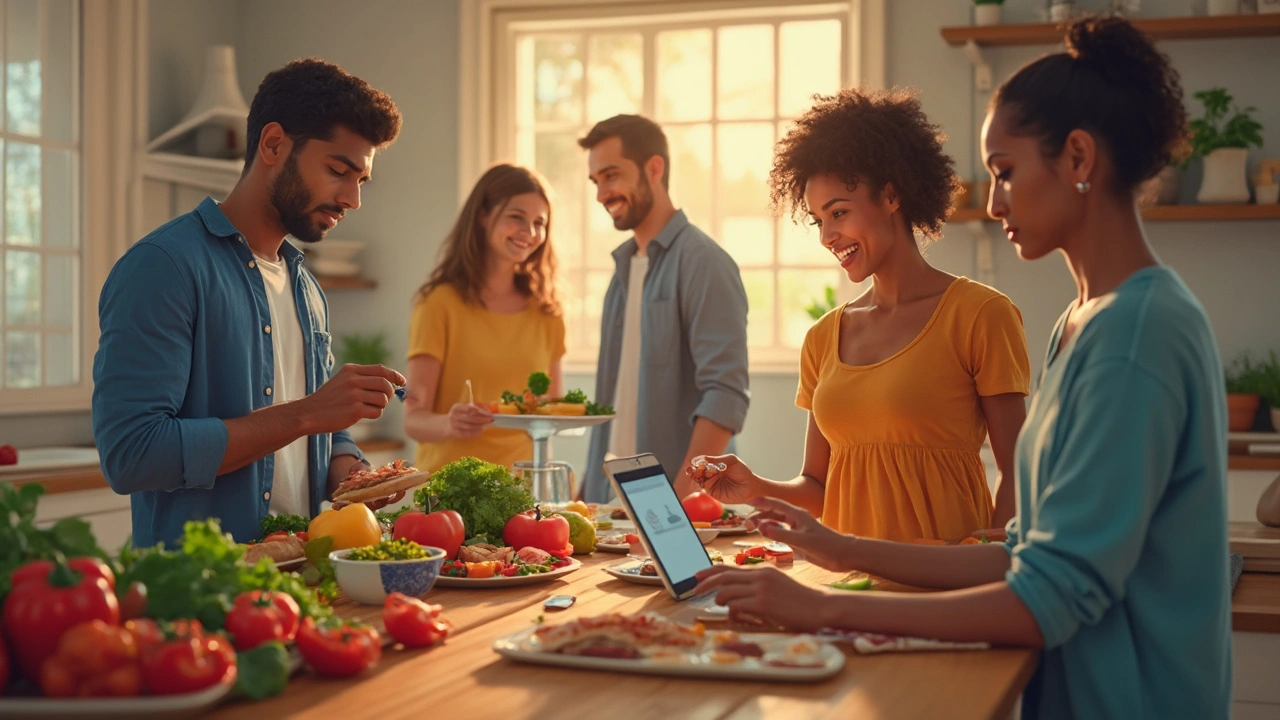Think you can always spot someone with diabetes just by looking at them? Or that only people who eat lots of sugar get it? These are just some of the wild stories that swirl around diabetes type 2, but the truth looks nothing like the gossip. Whether you’ve just been diagnosed, are supporting a family member, or simply want to check your facts, you’re in the right place. There’s a mountain of misinformation out there, and believing the wrong thing can take you off track. Let’s roll up our sleeves and brush off the old tales that make diabetes harder—instead, let’s get real about what helps and what doesn’t.
Diabetes Type 2 Isn’t Just Caused by Eating Sugary Foods
Here’s a popular myth: people get diabetes type 2 because they eat too many sweets. The truth? It’s not that simple. Type 2 diabetes develops when your body can't use insulin properly, not just because of your sweet tooth. Sure, eating loads of unhealthy processed sugar isn’t wise for anyone, but you could skip dessert every night and still be at risk.
Genetics play a big part. If a parent or grandparent had type 2, your risk jumps. Lifestyle matters, but it’s a mix of things: being overweight, inactivity, getting older, or health conditions like high blood pressure. Even stress can mess with your blood sugar! And here's a fact you might not expect: People of South Asian, African, or Indigenous descent, like many folks right here in Durban, have a higher risk, even before sugar enters the picture.
So can you eat sugar with type 2? Moderation is key. Swapping out sugary fizzy drinks for water or rooibos tea is a simple win, but you don’t need to swear off every birthday cake forever. What really matters is the bigger picture: eating balanced meals, watching portion sizes, and choosing fiber-rich foods more often. It's all about the daily choices that add up—one treat won’t ruin your health, but healthy habits can go a long way.
Take a look at these numbers:
| Country | Diabetes Type 2 Prevalence (%) |
|---|---|
| South Africa | 9.3 |
| India | 8.9 |
| USA | 10.5 |
It’s clear diabetes type 2 isn’t just a “sugar lover’s” disease. So next time someone offers you a soetkoekie, remember—moderation beats myth any day.
You Can Have Diabetes Type 2 Without Any Symptoms
The idea that diabetes always shouts its presence couldn’t be more wrong. Many people have no clue they have it—sometimes for years. You can go about your life, feeling more or less okay, while your blood sugar quietly creeps up. Don’t wait for obvious signs like constant thirst or peeing all the time. Studies from the International Diabetes Federation show that nearly half the people with type 2 in South Africa have no clue they’re living with it.
So what’s going on? Some signs—like being tired all the time, slow-healing cuts, or blurry vision—could be shrugged off as just getting older or feeling run down. But these sneaky signals are why regular check-ups matter so much, especially if you’ve got risk factors. Spotting problems early means you can take action sooner – and often, small changes make a big difference.
Some people feel fine while their blood sugar is way too high. Others might see weight loss or gain without trying. Don’t be fooled—just because you don’t “feel diabetic” doesn’t mean you don’t have it. If you’ve got a family history, are carrying extra weight, especially around your belly, or had gestational diabetes during pregnancy, book a quick HbA1c blood test with your clinic. It’s way better than being caught off guard down the line.
I know someone—a retired schoolteacher here in Durban—who was shocked to learn about her diabetes at a routine eye check. She had no obvious symptoms but caught the disease before any damage was done. Early diagnosis is a game-changer: you can keep living your life, but with a few clever tweaks.
Doctors use a simple blood test to check your average blood sugar over the past three months, called HbA1c. Here’s how to read it:
| Result | HbA1c (%) |
|---|---|
| Normal | Below 5.7 |
| Pre-diabetes | 5.7 - 6.4 |
| Diabetes | 6.5 or higher |
The bottom line? Don’t wait for symptoms. Get checked if you’re at risk, and you’ll stay one step ahead.

You Don’t Have to Give Up All Your Favourite Foods
So many people panic about diet after being diagnosed. The first thing that runs through their mind is, “Will I ever eat bread or amasi again?” Relax—a diagnosis isn’t a life sentence of lettuce leaves and misery. South African cuisine is full of smart swaps, and you can absolutely still enjoy your favourites.
The most important thing is balance. You don’t need to ditch carbs completely (in fact, your body needs some for energy). The trick is to go for slow, steady sources—think whole wheat pap, brown rice, beans, and lentils instead of refined white options. Load up on veg, go easy on fatty meats, and steer clear of hidden sugars in fizzy drinks, sauces, and processed snacks. That way, you take control without feeling deprived.
Here are some foods that people with type 2 diabetes can enjoy in moderation:
- Traditional maize meal porridge (non-instant, high-fiber options)
- Chicken stew with extra colourful veggies
- Sliced pawpaw, guava, or pineapple (just watch serving sizes)
- Home-made wholegrain seed bread
- Lean grilled boerewors (not every day, but now and then is fine)
One tip that’s helped lots of friends here in KwaZulu-Natal: Always fill half your plate with veg. It fills you up, keeps blood sugars steadier, and lets you enjoy a small piece of that rich malva pudding without guilt.
If you want a sweet treat, choose natural options like dates or dried mango (in small amounts). And when you’re out at a braai, go for extra salad and skip the second beer. The bottom line? With a few clever tweaks, you can still enjoy local favourites and live well. Anyone who says people with diabetes type 2 can never touch carbs again is buying into a myth—food is meant to be enjoyed, not feared.
Exercise Isn’t Optional—But You Don’t Have to Run Marathons
A lot of people think battling diabetes means hitting the gym every day or buying fancy exercise gear. Not at all. You don’t need to train like the Springboks to control blood sugar. Regular movement makes a massive difference, but it doesn’t have to be complicated or extreme.
Simple activities count: walking the dog, dancing to amapiano in your living room, even sweeping the stoep all add up. The World Health Organization recommends at least 150 minutes of moderate exercise a week. That’s just 30 minutes, five times a week—totally doable for most people. You could even break it into three brisk 10-minute walks a day if you’re busy raising kids or juggling work.
Why does movement matter? Regular activity helps your body use insulin better, directly lowering blood sugar. It’s proven to help keep your weight in check, lower your risk of heart disease, and boost your mood. For people already diagnosed, exercise can reduce the need for medication and protect against complications like nerve damage or foot problems.
I once joined a group of local gogos for their morning walk (before the Durban sun gets too fierce). Chatting, laughing, enjoying fresh air—the social side made it fun, not a chore. If gyms aren’t your thing, try a YouTube dance workout, stretch with a yoga mat, or sign up for community soccer. Even gardening and looking after grandkids can get your heart pumping.
Here’s a table comparing different activities and their average calories burned per 30 minutes, to give you some ideas:
| Activity | Calories Burned (70kg person) |
|---|---|
| Brisk walk | 140 |
| Walking stairs | 200 |
| Soccer | 215 |
| Dancing | 230 |
| Gardening | 150 |
If you haven’t exercised in a while, check with your doctor first. Start slow, listen to your body, and celebrate every bit of progress. Forget about needing to train like a pro—aim for more movement, however you can. That's a winning strategy.

Having Diabetes Type 2 Doesn’t Mean Life Stops or You’ll Definitely Face Complications
One gigantic myth that floats around is that type 2 diabetes means your life is suddenly over, or at best, downhill from here. That’s not true. With modern treatments, tech, and a few daily habits, most people live normal, healthy lives—some even feel better than before their diagnosis. Yes, blood sugar is important, but so are healthy routines, regular check-ups, and some self-kindness.
A diabetes diagnosis is serious, but it’s not a death sentence. More than five million South Africans live with it every day, from sports stars to grandparents, and they’re not giving up on their dreams. Yes, complications like vision problems, nerve damage, kidney issues, or heart disease are real risks, but consistent management cuts that risk way down. South Africa now has many diabetes clinics, support groups, and community resources, especially in big cities like Durban and Johannesburg. That means it’s easier than ever to get advice, share experiences, and not feel alone.
Technology is changing everything rapidly. Continuous glucose monitors (like the small round sensors you might have spotted on someone’s arm) now make it easier to check your blood sugar without endless finger pricks. Apps can track your meals, remind you to take medication, and even let your doctor check in on your data between visits. Medications have improved too, giving better control with fewer side effects for many people.
There are even local charity walks, park runs, and TikTok creators sharing simple, practical recipes (I love @diabetesfriendlysa, whose recipes are perfect for Durban’s climate). Support networks matter. Research has shown people with social support are far more likely to keep blood sugar steady and avoid burnout.
Here’s what actually helps:
- Keeping routines—meals, sleep, and activity help your body adapt
- Tracking and celebrating small milestones (like lower HbA1c numbers)
- Finding a buddy—whether a partner, friend, or neighbor—who “gets” it
- Being gentle with yourself (nobody eats perfectly or exercises every day!)
Anyone telling you that life “ends” with a diabetes diagnosis is stuck in the dark ages. Every person’s journey is unique, but with support, a personalised plan, and realistic goals, you can absolutely thrive—living proof is everywhere you look.
If you’re working, raising kids, volunteering, or just enjoying retirement, diabetes doesn’t have to slow you down. Self-management is the golden key, and you don’t need to do it alone. It's a journey—and believe me, there's still plenty of road (and good food) ahead.
